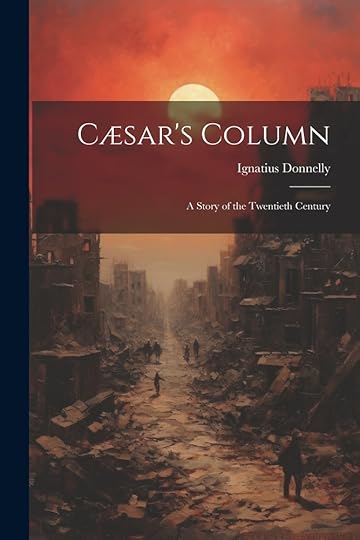Caesar’s Column: Minnesota Author’s Early Vision of Dystopia and Alternate History

I’ve always been fascinated by alternate history—the idea of asking “what if?” and exploring paths not taken. It’s a big part of why I wrote Reclaiming Mni Sota, my own novel imagining a different outcome for Minnesota’s 1862 conflict between settlers and Indigenous people.
But alternate history isn’t new to Minnesota literature. More than a century before I was writing, Ignatius Donnelly, a Minnesota politician and populist, published one of the most striking dystopian novels of the 19th century: Caesar’s Column: A Story of the Twentieth Century.
Published in 1890, Caesar’s Column was a huge success in its time, selling over 250,000 copies. It’s a grim, apocalyptic vision of the future—an alternate 1988 New York ruled by a brutal capitalist oligarchy and torn apart by violent revolution.
A Minnesota Author’s Dark VisionDonnelly was no stranger to big ideas. He was famous for his popular nonfiction on Atlantis and for drafting the 1892 Populist Party platform, which railed against what he called “a vast conspiracy against mankind.” His novel Caesar’s Column reflects these anxieties in fiction.
Written as a series of letters (an epistolary novel), Caesar’s Column follows Gabriel Weltstein, a wool merchant from Uganda who visits New York by airship. The city is enormous—ten million people—ruled by an oligarchy that maintains order through a vast police force and a fleet of armored dirigibles called “demons.”
Weltstein quickly discovers the misery of the working classes, who live in hopeless poverty. He becomes involved with a revolutionary movement, the Brotherhood of Destruction, led by the fearsome Caesar Lomellini—a man whose farm was foreclosed by bankers and who seeks revenge at any cost.
A Violent Uprising—and a Monument to Civilization’s EndDonnelly’s New York is dazzling in its imagined technologies—airships, televised newspapers, menus on screens—but rotten to the core. The oligarchs are corrupt and merciless, and the rebellion that topples them is just as brutal.
When the uprising comes, the Brotherhood destroys the police, sacks the city, and turns to wholesale slaughter in revenge. At the height of the bloodshed, Caesar orders the dead piled in Union Square and entombed in concrete, creating the monument that gives the novel its title:
“We won’t make a pyramid of it—it shall be a column—Caesar’s Column… It shall reach to the skies! And if there aren’t enough dead to build it of, why, we’ll kill some more.”
An inscription on the column declares:
“This great monument is erected… in commemoration of the death and burial of modern civilization.”
In the chaos that follows, even the revolutionaries lose control. Weltstein flees the burning city by airship and eventually escapes to Uganda, where he helps found a utopian society with a new constitution promising liberty, education, security, and abundance for all.
Populism, Dystopia, and Alternate HistoryCaesar’s Column is a deeply political book. Donnelly used it to warn about the concentration of wealth and power he saw in the Gilded Age—a warning that feels remarkably modern. At the same time, the novel is steeped in the fears, prejudices, and contradictions of its era.
It’s a dystopian fantasy, but also an alternate history: Donnelly didn’t just extrapolate technology, he imagined a different trajectory for civilization—one shaped by revolution, collapse, and attempted renewal.
That’s something I find compelling about the genre. In Reclaiming Mni Sota, I tried to do something similar, asking: what if the Dakota and Ojibwe peoples successfully united and reclaimed Minnesota? What would that victory mean for them, for settlers, and for the shape of American history?
Why Read Caesar’s Column Today?More than 130 years later, Donnelly’s novel is still unsettling. It’s part social critique, part science fiction, part nightmare prophecy. As a Minnesota author, I’m struck by the ambition of his vision—and the power of alternate history to challenge us to see the past, and the future, with new eyes.
If you’re interested in dystopian classics, political fiction, or the roots of alternate history as a genre, Caesar’s Column is worth exploring—even if just to see what one Minnesotan imagined our future might become.
 Discover an alternate history set in Minnesota.
Discover an alternate history set in Minnesota. In Reclaiming Mni Sota, the true and lasting results of history are challenged. Acting as individuals, striving to protect ourselves and our families, it’s impossible to understand our role and impact in the much larger march of time. The United States is an abundant, beautiful land filled with wealth and opportunity, but its history is scarred by inequity and loss. What if the defeated became the victors? What would that mean for the world today and how would that illuminate the wrongs of the past?



